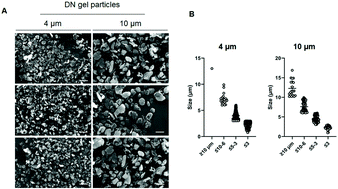Evaluation of biological responses to micro-particles derived from a double network hydrogel†
Abstract
Double network hydrogels (DN gels) composed of poly (2-acrylamido-2-methyl propanesulfonic acid) (PAMPS) as the brittle first network and poly (N,N-dimethylacrylamide) (PDMA) as the ductile second network have been proven to be a substitute biomaterial for cartilage, with promising biocompatibility and low toxicity, when they are used as bulk materials. For their further applications as articular cartilages, it is essential to understand the biological reactions and adverse events that might be initiated by wear particles derived from these materials. In this study, we used DN gel micro-particles of sizes 4 μm and 10 μm generated by the grinding method to mimic wearing debris of DN gels. The biological responses to particles were then evaluated in a macrophage-cultured system and an inflammatory osteolysis murine model. Our results demonstrated that DN gel particles have the ability to activate macrophages and promote the expression of Tnf-α, both in vitro and in vivo. Furthermore, the implantation of these particles onto calvarial bone triggered local inflammation and bone loss in a mouse model. Our data reveal that the potential foreign body responses to the generated particles from artificial cartilage should receive more attention in artificial cartilage engineering with the goal of developing a safer biocompatible substitute.



 Please wait while we load your content...
Please wait while we load your content...